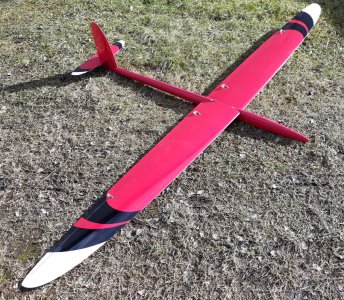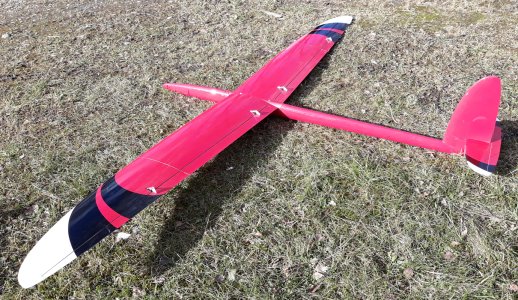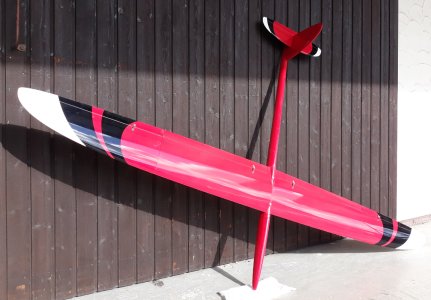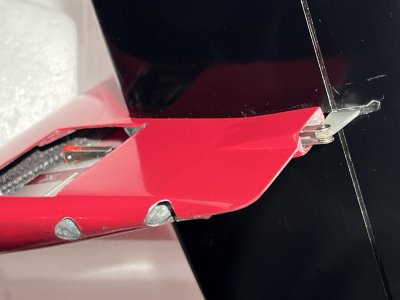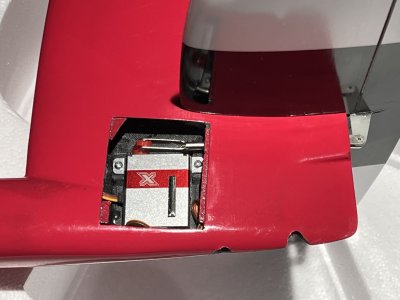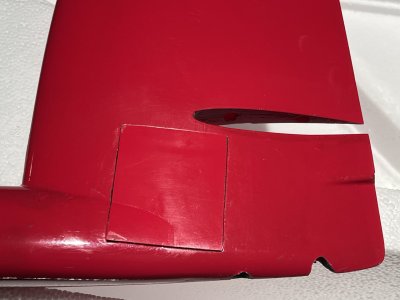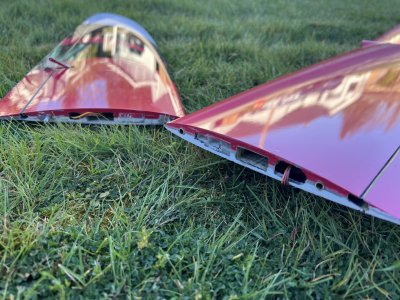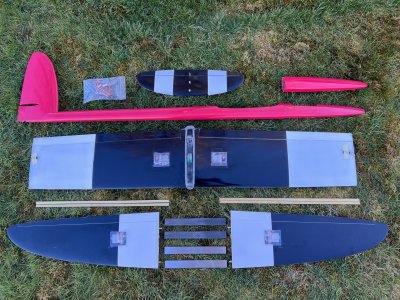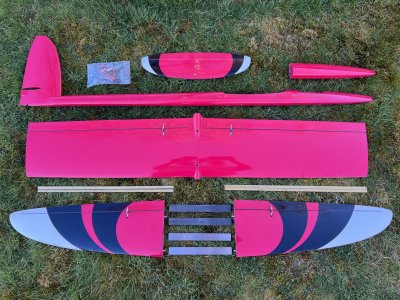Artur Blömker
User
Vorgeschichte
Konstruiert, CAD erstellt und Negative gefräst in den Jahren 2011 und 2012. Entwürfe des Modells hatten ich vorgestellt auf dynamic-soaring.de, wo wir ein spezielles DS-Forum betrieben. 2014 haben wir das DS-Forum wegen des doch immensen Aufwands eingestellt, RCN hat die DS-Sparte dann hier fortgeführt: https://www.rc-network.de/threads/willkommen-im-ds-forum.461983/
Lokale DS-Hänge verloren
Noch vor Erstellung der Negative jedoch verloren wir in unserer Region innerhalb kürzester Zeit alle 3 Spots für schnelles DS! Das hatte mich bewogen, die nahezu fertig geschliffenen Positive zu verkaufen. Markus Minger und Sandro Bosshard (Insider Modellbau) kauften die Positive in 2013 und brachten diese in die Schweiz.
Die Zeit verging.
Im Dezember 2021 jedoch erhielt ich von Ernst Göbel (fiberplanes.de) ein Foto des ersten Modells, welche den von ihm fertiggestellten Negativen entsprungen ist. Unglaublich! Ja stimmt. Da war ja mal was.
Das nehme ich heute zum Anlass für die Bekanntgabe einiger Projekt-Details. Der Name des Modells hat wohl irgendetwas mit meinem Vornamen zu tun.
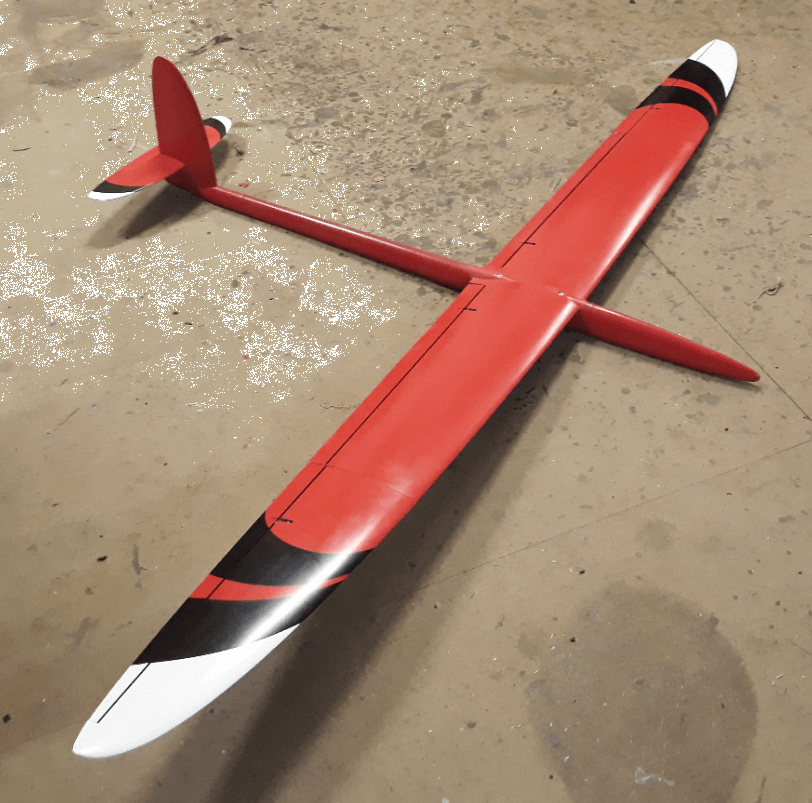
Konstruktionsvorgaben
Einigermaßen hohe Flächenbelastung auch bei Fluggewicht < 5 kg (gesetzliche Vorgaben); kompakte Maße beim Transport; kein Limit bezüglich Belastbarkeit; kein Fokus auf Allround-Fähigkeit, sondern ein reines DS-Modell.
Überblick
Spannweite 2,30 m
Streckung 12,66
Flächeninhalt 41,6 dm²
Profiltiefe in der Mitte 220 mm
Fluggewicht 3,5 kg bis 4,99 kg (D) oder auch ca. 8 kg wo erlaubt
leicht überelliptische Tiefenverteilung, berechnet mit FLZ Vortex
Profile an die Rezahl angepasst durch Variation der Dickenrücklage
keine geometrische oder aerodynamische Verwindung oder deren Kombination
Profil mittig (Root) 9,57 % Dicke
Max. Dicke bei 41,9 %
1,75 % Wölbung
Wölbungsrücklage 45,5 %

Profil außen (Tip) bei 100 mm 9,14 % Dicke
Max. Dicke bei 34,9 %
1,75 % Wölbung
Wölbungsrücklage 44,6 %

Tragfläche
Die Tragfläche ist ganz leicht nach vorn gepfeilt, damit Turbulenzen des Rumpfes die Tragfläche etwas weniger beeinflussen.

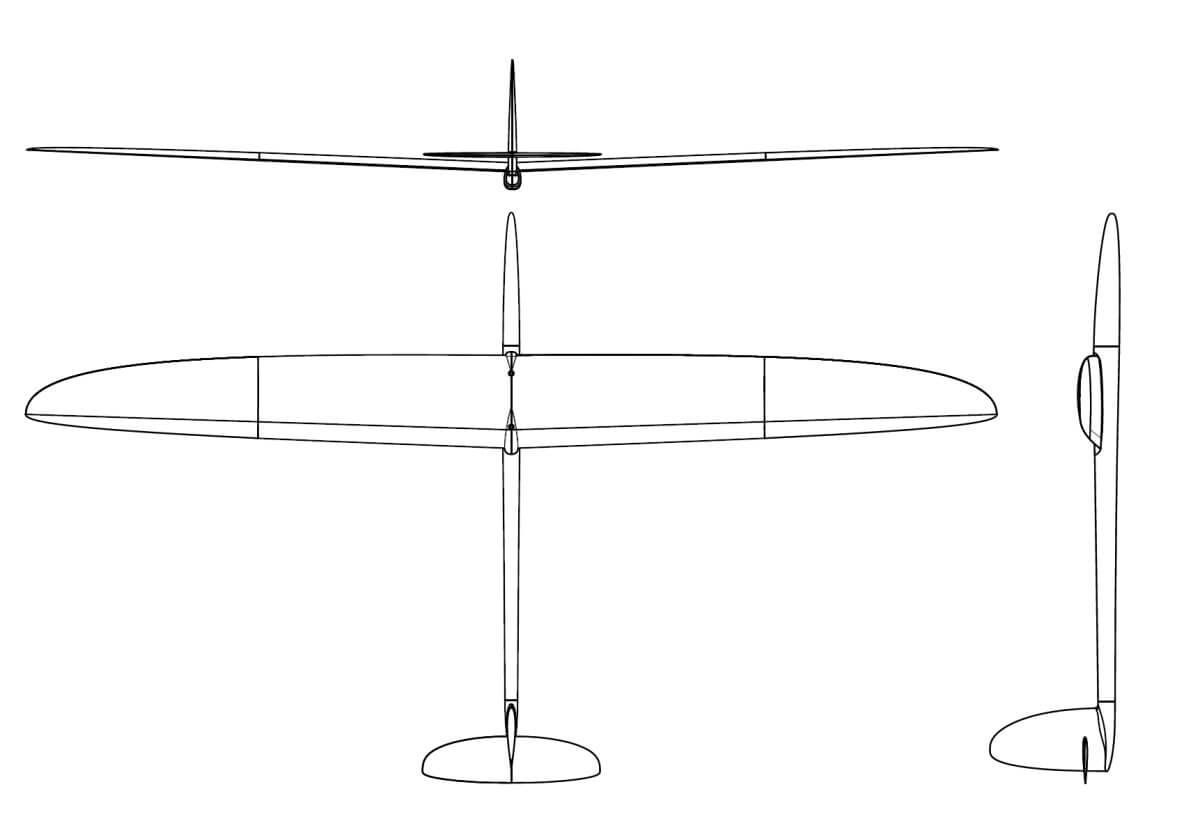
Scharnierlinie
Sven Hollenbeck (formenzauber.de) hat einige Details am CAD ermöglicht, die nicht alltäglich sind. So hat er meinen Wunsch umgesetzt, dass bei der Tragfläche die Scharnierlinie sowohl bei den Wölbklappen als auch den Querrudern bis zum Randbogen hin gerade ist - damit meine ich nicht die Draufsicht, sondern die Vorderansicht (ein Lineal auf die Scharnierlinie gelegt = 100 % gerade). Man kann das sehen in der Zeichnung - daher ist die Flächenunterseite gerade und die Oberseite leicht gebogen.
Somit ist die Scharnierlinie immer völlig gerade, was eine spannungsfreie Anlenkung ermöglicht, zusätzlich ermöglicht es die Option, die Querruder bis zum Randbogen auszuschneiden.
Auftriebsverteilung
Bei der Fläche habe ich 20 % Klappentiefe vorgesehen, wiederum durch die in alle Richtungen gerade Scharnierline wird bei Snapflap kein sich vergrößernder Spalt entstehen. Der Spalt zwischen Querrudern und Wölbklappen kann sehr klein ausfallen. Die Auftriebsverteilung wird sich gleichmäßig ändern bei einem Klappenausschlag - das Profil kann so optimale Leistungen erbringen. Die Querruder gehen ganz nach außen bis zum Randbogen. 20 % Rudertiefe habe ich gewählt, weil wir beim DS-Fliegen feststellen konnten, dass bei hoher Geschwindigkeit kleinste Ruderausschläge genügen.
Im schnellen DS sollten die Querruder und Wölbklappen im Strak ca. 2-3 Grad nach oben eingestellt sein, per Snap-Flap dann beide herunter auf 0 Grad. Im Langsamflug gehen die Wölbklappen mit den Querrudern 1:1 mit. Im Schnellflug bewegen sich nur noch die Querruder (mit viel Expo) und natürlich Snapflap.
Ruder-Anlenkung
Zum Zeitpunkt der Konstruktion waren Servos von Volz und z.B. das Futaba 3150 üblich. Heutige Servos haben deutlich mehr Kraft, was das Thema Anlenkung etwas vereinfacht. Anfang 2022 werden wohl die neuen KST A12 Torque V8 auf den Markt kommen, die wären optimal passend.
Profilstrak
Die Profile sind vorne rund und hinten spitz.
Es gibt ein Profil in der Flächenmitte (Root) - und eines der Rezahl angepasstes Profil (Tip) in der Nähe des Randbogens (bei 100 mm Tiefe). Eine geometrische oder aerodynamische Verwindung gibt es nicht, der Nullauftriebswinkel der Profile ist gleich. Normal wäre nun, diese beiden Profile am CAD linear zu straken. Manche errechnen auch 3 oder 4 oder noch mehr Zwischenprofile und straken dann linear dazwischen.
Sven hat es auf meinen Wunsch hin umgesetzt, dass dieser Strak nun im Verhältnis der Flächentiefe verläuft, denn schließlich ist das jeweilige Profil für einen bestimmten Rezahlbereich entworfen - und die Rezahl hängt von der Flächentiefe ab. Jedenfalls sollte technisch Mögliches auch umgesetzt werden.
Steckung der 3-teiligen Tragfläche
Die Steckung ist so dimensioniert, dass auch CFK als Verbinder genügt. Daher habe ich 2 Verbinder mit 5 mm Steg dazwischen vorgesehen. Maß je Verbinder ist 10 mm dick und 25 mm breit. Das sollte genügen! Übertreiben bezüglich Stabilität kann man im DS meiner Meinung nach nicht.
Rumpf mit 2 Steckungen
Wenn man genau schaut, es gibt eine Aufsteckhaube, sowie eine Steckung hinten vor dem Seitenleitwerk. Somit kann der Rumpf in Aufblastechnik und das Seitenleitwerk in Vakuumtechnik gebaut werden. Sollten am Rumpf oder Leitwerk Änderungen gewünscht sein (zum Beispiel T-Leitwerk) - braucht man nur das Seitenleitwerk neu fräsen.
Die Aufstecknase war mein Wunsch, weil ich aus Transportgründen möchte, dass kein Teil des Modells länger als 1,20 m ist. Das Flächenmittelstück ist auch 1,20 m lang. Die Haube hat 2 mm (!) Wandstärke und somit für sich allein stabil genug, so dass innerhalb der Haube der Innenrumpf gekürzt werden kann, falls ein 1,20 m Rumpf gewünscht ist.
Der Rumpfquerschnitt ist oval, damit die Anlenkung eines starken und schnellen Höhenruderservos Platz genug hat. Das Servo wird hängend eingebaut. Der Rumpfquerschnitt hinten ist sehr üppig - aber das halte ich auch wegen der großen Belastung und der Steckung für angesagt.
Höhenleitwerk:
2 Stück M4-Muttern werden in das HLW eingeklebt, es wird von unten (2 Öffnungen unten im Rumpf für den Schraubendreher) verschraubt. Das Servo kommt vorn in den Rumpf, damit das Heck insgesamt nicht so schwer wird. Das Seitenleitwerk ist in Rumpfnähe sehr dick, damit genug Auflage für das HLW entsteht. Die Anlenkung des HLW geschieht außerhalb des Rumpfes, allerdings hat das Seitenleitwerk direkt unter dem HLW einen Bereich einer offenen Endleiste - und zwar so, dass ein Gabelkopf gerade noch hindurchpasst.
Die Scharnierlinie des Höhenleitwerks ist ebenfalls absolut gerade bis zum Randbogen. So wird sich das (gedämpfte) Ruder entsprechend spannungsfrei bewegen können. Die Scharnierlinie beim Höhenleitwerk ist oben.
Die Klappentiefe beim Höhenleitwerk beträgt 25 %. Die Profile für das Seiten- und Höhenleitwerk sind so gewählt, dass man im Langsamflug kein Problem bekommt.
Bau und Erstflug des Modells
Da ist nun Ernst Göbel gefordert.
Bin jedenfalls sehr gespannt, ob und wie das Modell dann fliegt.
Herzliche Grüße - Artur
Konstruiert, CAD erstellt und Negative gefräst in den Jahren 2011 und 2012. Entwürfe des Modells hatten ich vorgestellt auf dynamic-soaring.de, wo wir ein spezielles DS-Forum betrieben. 2014 haben wir das DS-Forum wegen des doch immensen Aufwands eingestellt, RCN hat die DS-Sparte dann hier fortgeführt: https://www.rc-network.de/threads/willkommen-im-ds-forum.461983/
Lokale DS-Hänge verloren
Noch vor Erstellung der Negative jedoch verloren wir in unserer Region innerhalb kürzester Zeit alle 3 Spots für schnelles DS! Das hatte mich bewogen, die nahezu fertig geschliffenen Positive zu verkaufen. Markus Minger und Sandro Bosshard (Insider Modellbau) kauften die Positive in 2013 und brachten diese in die Schweiz.
Die Zeit verging.
Im Dezember 2021 jedoch erhielt ich von Ernst Göbel (fiberplanes.de) ein Foto des ersten Modells, welche den von ihm fertiggestellten Negativen entsprungen ist. Unglaublich! Ja stimmt. Da war ja mal was.

Das nehme ich heute zum Anlass für die Bekanntgabe einiger Projekt-Details. Der Name des Modells hat wohl irgendetwas mit meinem Vornamen zu tun.


Konstruktionsvorgaben
Einigermaßen hohe Flächenbelastung auch bei Fluggewicht < 5 kg (gesetzliche Vorgaben); kompakte Maße beim Transport; kein Limit bezüglich Belastbarkeit; kein Fokus auf Allround-Fähigkeit, sondern ein reines DS-Modell.
Überblick
Spannweite 2,30 m
Streckung 12,66
Flächeninhalt 41,6 dm²
Profiltiefe in der Mitte 220 mm
Fluggewicht 3,5 kg bis 4,99 kg (D) oder auch ca. 8 kg wo erlaubt
leicht überelliptische Tiefenverteilung, berechnet mit FLZ Vortex
Profile an die Rezahl angepasst durch Variation der Dickenrücklage
keine geometrische oder aerodynamische Verwindung oder deren Kombination
Profil mittig (Root) 9,57 % Dicke
Max. Dicke bei 41,9 %
1,75 % Wölbung
Wölbungsrücklage 45,5 %

Profil außen (Tip) bei 100 mm 9,14 % Dicke
Max. Dicke bei 34,9 %
1,75 % Wölbung
Wölbungsrücklage 44,6 %

Tragfläche
Die Tragfläche ist ganz leicht nach vorn gepfeilt, damit Turbulenzen des Rumpfes die Tragfläche etwas weniger beeinflussen.


Scharnierlinie
Sven Hollenbeck (formenzauber.de) hat einige Details am CAD ermöglicht, die nicht alltäglich sind. So hat er meinen Wunsch umgesetzt, dass bei der Tragfläche die Scharnierlinie sowohl bei den Wölbklappen als auch den Querrudern bis zum Randbogen hin gerade ist - damit meine ich nicht die Draufsicht, sondern die Vorderansicht (ein Lineal auf die Scharnierlinie gelegt = 100 % gerade). Man kann das sehen in der Zeichnung - daher ist die Flächenunterseite gerade und die Oberseite leicht gebogen.
Somit ist die Scharnierlinie immer völlig gerade, was eine spannungsfreie Anlenkung ermöglicht, zusätzlich ermöglicht es die Option, die Querruder bis zum Randbogen auszuschneiden.
Auftriebsverteilung
Bei der Fläche habe ich 20 % Klappentiefe vorgesehen, wiederum durch die in alle Richtungen gerade Scharnierline wird bei Snapflap kein sich vergrößernder Spalt entstehen. Der Spalt zwischen Querrudern und Wölbklappen kann sehr klein ausfallen. Die Auftriebsverteilung wird sich gleichmäßig ändern bei einem Klappenausschlag - das Profil kann so optimale Leistungen erbringen. Die Querruder gehen ganz nach außen bis zum Randbogen. 20 % Rudertiefe habe ich gewählt, weil wir beim DS-Fliegen feststellen konnten, dass bei hoher Geschwindigkeit kleinste Ruderausschläge genügen.
Im schnellen DS sollten die Querruder und Wölbklappen im Strak ca. 2-3 Grad nach oben eingestellt sein, per Snap-Flap dann beide herunter auf 0 Grad. Im Langsamflug gehen die Wölbklappen mit den Querrudern 1:1 mit. Im Schnellflug bewegen sich nur noch die Querruder (mit viel Expo) und natürlich Snapflap.
Ruder-Anlenkung
Zum Zeitpunkt der Konstruktion waren Servos von Volz und z.B. das Futaba 3150 üblich. Heutige Servos haben deutlich mehr Kraft, was das Thema Anlenkung etwas vereinfacht. Anfang 2022 werden wohl die neuen KST A12 Torque V8 auf den Markt kommen, die wären optimal passend.
Profilstrak
Die Profile sind vorne rund und hinten spitz.

Es gibt ein Profil in der Flächenmitte (Root) - und eines der Rezahl angepasstes Profil (Tip) in der Nähe des Randbogens (bei 100 mm Tiefe). Eine geometrische oder aerodynamische Verwindung gibt es nicht, der Nullauftriebswinkel der Profile ist gleich. Normal wäre nun, diese beiden Profile am CAD linear zu straken. Manche errechnen auch 3 oder 4 oder noch mehr Zwischenprofile und straken dann linear dazwischen.
Sven hat es auf meinen Wunsch hin umgesetzt, dass dieser Strak nun im Verhältnis der Flächentiefe verläuft, denn schließlich ist das jeweilige Profil für einen bestimmten Rezahlbereich entworfen - und die Rezahl hängt von der Flächentiefe ab. Jedenfalls sollte technisch Mögliches auch umgesetzt werden.
Steckung der 3-teiligen Tragfläche
Die Steckung ist so dimensioniert, dass auch CFK als Verbinder genügt. Daher habe ich 2 Verbinder mit 5 mm Steg dazwischen vorgesehen. Maß je Verbinder ist 10 mm dick und 25 mm breit. Das sollte genügen! Übertreiben bezüglich Stabilität kann man im DS meiner Meinung nach nicht.
Rumpf mit 2 Steckungen
Wenn man genau schaut, es gibt eine Aufsteckhaube, sowie eine Steckung hinten vor dem Seitenleitwerk. Somit kann der Rumpf in Aufblastechnik und das Seitenleitwerk in Vakuumtechnik gebaut werden. Sollten am Rumpf oder Leitwerk Änderungen gewünscht sein (zum Beispiel T-Leitwerk) - braucht man nur das Seitenleitwerk neu fräsen.
Die Aufstecknase war mein Wunsch, weil ich aus Transportgründen möchte, dass kein Teil des Modells länger als 1,20 m ist. Das Flächenmittelstück ist auch 1,20 m lang. Die Haube hat 2 mm (!) Wandstärke und somit für sich allein stabil genug, so dass innerhalb der Haube der Innenrumpf gekürzt werden kann, falls ein 1,20 m Rumpf gewünscht ist.
Der Rumpfquerschnitt ist oval, damit die Anlenkung eines starken und schnellen Höhenruderservos Platz genug hat. Das Servo wird hängend eingebaut. Der Rumpfquerschnitt hinten ist sehr üppig - aber das halte ich auch wegen der großen Belastung und der Steckung für angesagt.
Höhenleitwerk:
2 Stück M4-Muttern werden in das HLW eingeklebt, es wird von unten (2 Öffnungen unten im Rumpf für den Schraubendreher) verschraubt. Das Servo kommt vorn in den Rumpf, damit das Heck insgesamt nicht so schwer wird. Das Seitenleitwerk ist in Rumpfnähe sehr dick, damit genug Auflage für das HLW entsteht. Die Anlenkung des HLW geschieht außerhalb des Rumpfes, allerdings hat das Seitenleitwerk direkt unter dem HLW einen Bereich einer offenen Endleiste - und zwar so, dass ein Gabelkopf gerade noch hindurchpasst.
Die Scharnierlinie des Höhenleitwerks ist ebenfalls absolut gerade bis zum Randbogen. So wird sich das (gedämpfte) Ruder entsprechend spannungsfrei bewegen können. Die Scharnierlinie beim Höhenleitwerk ist oben.
Die Klappentiefe beim Höhenleitwerk beträgt 25 %. Die Profile für das Seiten- und Höhenleitwerk sind so gewählt, dass man im Langsamflug kein Problem bekommt.
Bau und Erstflug des Modells
Da ist nun Ernst Göbel gefordert.

Bin jedenfalls sehr gespannt, ob und wie das Modell dann fliegt.

Herzliche Grüße - Artur
Zuletzt bearbeitet:


